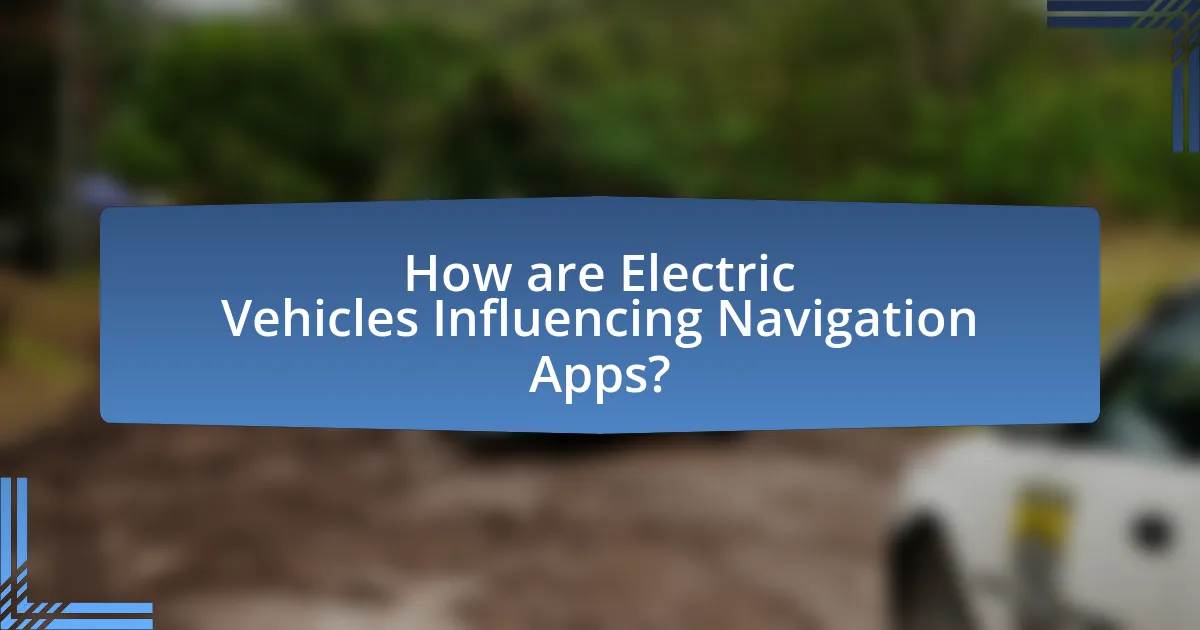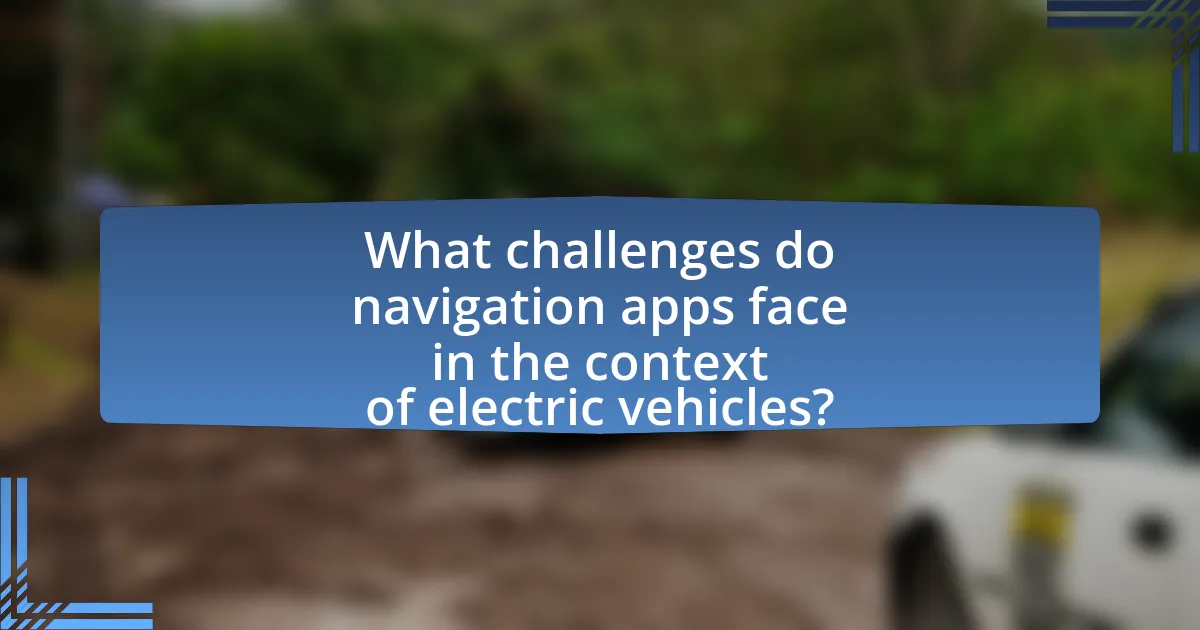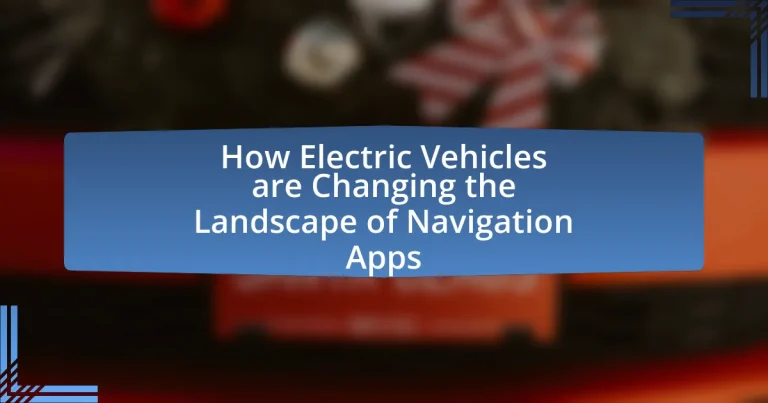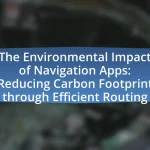Electric vehicles (EVs) are significantly transforming navigation apps by introducing features that cater specifically to the needs of EV users, such as real-time charging station locations and route optimization based on battery range. Key functionalities include energy consumption tracking, integration of charging station data, and the use of real-time traffic information to enhance route planning. The article explores how user preferences shape app development, the challenges posed by infrastructure limitations, and the technological advancements necessary for improving EV navigation. Additionally, it highlights the role of user-generated content and community features in app evolution, as well as best practices for developers to create user-friendly interfaces that accommodate diverse audiences.

How are Electric Vehicles Influencing Navigation Apps?
Electric vehicles are influencing navigation apps by integrating features that optimize routes based on charging station availability and battery range. Navigation apps now provide real-time data on charging locations, estimated charging times, and route adjustments to ensure drivers can reach their destinations without running out of battery. For example, apps like Google Maps and Waze have incorporated filters for electric vehicle charging stations, enhancing user experience and convenience. This shift is driven by the increasing adoption of electric vehicles, which, according to the International Energy Agency, saw a global sales increase of 43% in 2020, prompting navigation services to adapt to the unique needs of electric vehicle users.
What are the key features of navigation apps tailored for electric vehicles?
Navigation apps tailored for electric vehicles (EVs) include key features such as real-time charging station locations, route optimization based on charging needs, and energy consumption tracking. These apps provide users with the ability to find nearby charging stations, often displaying availability and charging speed, which is crucial for planning longer trips. Additionally, they optimize routes by considering the vehicle’s battery level and the locations of charging stations along the way, ensuring efficient travel without running out of power. Energy consumption tracking helps users monitor their vehicle’s efficiency, allowing for better planning and management of charging needs. These features are essential for enhancing the EV driving experience and addressing the unique challenges faced by electric vehicle owners.
How do charging station locations integrate into these navigation apps?
Charging station locations integrate into navigation apps through real-time data updates and mapping features that allow users to locate nearby charging points. These apps utilize GPS technology to pinpoint the user’s location and display available charging stations on the map, often including details such as station type, availability, and charging speed. For instance, apps like Google Maps and Waze have incorporated electric vehicle charging station data from networks such as ChargePoint and EVgo, enabling users to filter routes based on charging needs. This integration supports the growing demand for electric vehicle infrastructure, as evidenced by a report from the International Energy Agency, which noted that the number of public charging points worldwide reached over 1.3 million in 2021, highlighting the importance of accessible charging information in navigation systems.
What role does real-time traffic data play in electric vehicle navigation?
Real-time traffic data is crucial for electric vehicle navigation as it optimizes route planning and enhances energy efficiency. By providing up-to-date information on traffic conditions, navigation systems can suggest the most efficient paths, reducing travel time and energy consumption. For instance, studies show that integrating real-time traffic data can lead to a 20% reduction in energy usage during trips, as vehicles can avoid congested areas and select routes that minimize stops and starts. This capability not only improves the driving experience but also extends the range of electric vehicles by conserving battery power.
Why is route optimization important for electric vehicles?
Route optimization is crucial for electric vehicles because it enhances efficiency and maximizes battery range. By calculating the most efficient paths, route optimization minimizes energy consumption, which is vital for electric vehicles that have limited battery capacity compared to traditional vehicles. Studies indicate that optimized routes can increase the driving range by up to 20%, allowing electric vehicles to travel further on a single charge. Additionally, route optimization can incorporate real-time data on traffic, elevation changes, and charging station locations, ensuring that electric vehicles can complete their journeys without running out of power.
How do navigation apps calculate the most efficient routes for EVs?
Navigation apps calculate the most efficient routes for electric vehicles (EVs) by integrating real-time data on traffic conditions, road types, and charging station locations. These apps utilize algorithms that consider the vehicle’s battery range, energy consumption rates, and elevation changes to optimize routes. For instance, they may prioritize routes that minimize energy use, such as avoiding steep inclines or heavy traffic, which can drain battery life more quickly. Additionally, navigation apps often include information on nearby charging stations, allowing users to plan stops effectively based on their remaining battery capacity. This approach ensures that EV drivers can reach their destinations without running out of power, enhancing the overall driving experience.
What factors are considered in route planning for electric vehicles?
Route planning for electric vehicles considers several key factors, including battery range, charging station availability, terrain, and traffic conditions. Battery range is critical as it determines how far an electric vehicle can travel on a single charge, influencing the selection of routes that keep the vehicle within its operational limits. Charging station availability is essential for planning stops along the route, ensuring that drivers can recharge their vehicles when necessary. Terrain affects energy consumption, as hilly or mountainous routes may require more energy than flat ones. Traffic conditions are also factored in to optimize travel time and energy efficiency, as congested routes can lead to increased energy use. These factors collectively ensure that electric vehicle drivers can navigate effectively and efficiently.
How do user preferences shape the development of navigation apps for EVs?
User preferences significantly shape the development of navigation apps for electric vehicles (EVs) by driving the integration of features that enhance usability and efficiency. For instance, users prioritize real-time charging station availability, prompting developers to incorporate live data feeds that show nearby charging locations and their status. Additionally, preferences for route optimization based on charging needs lead to the implementation of algorithms that calculate the most efficient paths, considering factors like battery range and charging times. Research indicates that 70% of EV users consider charging infrastructure a critical factor in their navigation app choice, underscoring the importance of user feedback in app design.
What feedback mechanisms are in place for users of EV navigation apps?
EV navigation apps incorporate several feedback mechanisms to enhance user experience and app functionality. These mechanisms include user ratings and reviews, which allow users to provide direct feedback on routes, charging station availability, and app performance. Additionally, many apps feature in-app surveys or prompts that solicit user opinions on specific features or recent updates. Real-time feedback is also facilitated through community-driven data sharing, where users can report issues such as traffic conditions or charging station malfunctions, contributing to a dynamic and responsive navigation experience. These feedback systems are essential for continuous improvement and adaptation of the apps to meet user needs effectively.
How do user demographics influence app features and functionalities?
User demographics significantly influence app features and functionalities by dictating user preferences, behaviors, and needs. For instance, younger users may prioritize social sharing and gamification features, while older users might prefer straightforward navigation and accessibility options. Research indicates that 60% of app users aged 18-34 favor apps with social integration, whereas 70% of users over 50 value simplicity and ease of use (Pew Research Center, 2021). Additionally, geographic demographics can shape functionalities; urban users may require real-time traffic updates and public transport options, while rural users might need offline capabilities and route optimization for longer distances. Thus, understanding user demographics allows developers to tailor app features that enhance user experience and engagement.

What challenges do navigation apps face in the context of electric vehicles?
Navigation apps face significant challenges in optimizing routes for electric vehicles due to the need for accurate charging station data and range estimation. Electric vehicles require access to charging infrastructure, which varies in availability and reliability across different regions. For instance, a study by the International Council on Clean Transportation found that the distribution of charging stations is often uneven, leading to potential range anxiety for users. Additionally, navigation apps must integrate real-time data on charging station status, including availability and charging speed, to provide effective route planning. This complexity is compounded by the need to account for varying battery capacities and driving conditions, which can affect the vehicle’s range.
How do infrastructure limitations affect navigation app performance for EVs?
Infrastructure limitations significantly hinder navigation app performance for electric vehicles (EVs) by restricting access to charging stations and affecting route optimization. When charging infrastructure is sparse or poorly integrated into navigation systems, EVs may struggle to find optimal charging locations, leading to inefficient routes and increased travel times. For instance, a study by the International Council on Clean Transportation found that inadequate charging infrastructure can result in range anxiety, causing drivers to avoid longer trips. This limitation directly impacts the effectiveness of navigation apps, as they rely on real-time data to provide accurate routing and charging options. Consequently, the performance of navigation apps for EVs is compromised when infrastructure does not meet the growing demand for electric mobility.
What are the common issues related to charging station availability?
Common issues related to charging station availability include insufficient infrastructure, long wait times, and inconsistent charging speeds. Insufficient infrastructure arises from a lack of charging stations in certain areas, leading to limited access for electric vehicle users. Long wait times occur when demand exceeds supply, particularly in urban locations or during peak travel times. Inconsistent charging speeds can frustrate users, as some stations may not deliver the expected power output, affecting charging duration. According to a study by the International Council on Clean Transportation, the U.S. will need to increase its public charging infrastructure significantly to meet the growing demand for electric vehicles, highlighting the urgency of addressing these issues.
How does the lack of standardized data impact navigation accuracy?
The lack of standardized data significantly reduces navigation accuracy by introducing inconsistencies in route information and location data. When navigation systems rely on varied data sources, discrepancies in road conditions, traffic patterns, and geographic information can lead to incorrect routing and estimated arrival times. For instance, a study by the National Highway Traffic Safety Administration found that inconsistent data can result in navigation errors that increase travel time by up to 20%. This inconsistency hampers the ability of navigation apps to provide reliable guidance, particularly for electric vehicles that depend on precise routing for efficient battery management and charging station access.
What technological advancements are needed for better EV navigation?
Technological advancements needed for better EV navigation include enhanced real-time data integration, improved charging station mapping, and advanced route optimization algorithms. Real-time data integration allows navigation systems to access live traffic conditions, weather updates, and charging station availability, which are crucial for efficient route planning. Improved charging station mapping ensures that drivers can easily locate charging points along their routes, with accurate information on charging speeds and availability. Advanced route optimization algorithms can calculate the most efficient paths based on battery range, terrain, and energy consumption patterns, ultimately enhancing the driving experience for EV users. These advancements are supported by the growing demand for seamless navigation solutions in the rapidly expanding electric vehicle market.
How can artificial intelligence improve route planning for electric vehicles?
Artificial intelligence can improve route planning for electric vehicles by optimizing routes based on real-time data, including traffic conditions, charging station availability, and battery levels. AI algorithms analyze vast amounts of data to predict the most efficient paths, reducing travel time and energy consumption. For instance, AI can dynamically adjust routes to include charging stops based on the vehicle’s current battery status and the distance to the destination, ensuring that drivers do not run out of power. Studies have shown that AI-enhanced navigation systems can increase the efficiency of electric vehicle travel by up to 30%, demonstrating the significant impact of AI on route planning.
What innovations are being explored to enhance user experience in EV navigation apps?
Innovations being explored to enhance user experience in EV navigation apps include real-time charging station availability, route optimization based on battery range, and integration with smart home systems. Real-time charging station availability allows users to locate nearby charging points and check their status, improving convenience during travel. Route optimization based on battery range ensures that users can plan their trips efficiently, taking into account the vehicle’s current charge and the locations of charging stations along the route. Integration with smart home systems enables users to precondition their vehicles and manage charging schedules remotely, enhancing overall usability and convenience. These innovations are supported by advancements in GPS technology and data analytics, which provide accurate and timely information to users.

How are navigation apps adapting to the growing electric vehicle market?
Navigation apps are adapting to the growing electric vehicle market by integrating features that cater specifically to EV users, such as real-time charging station locations and route optimization for battery efficiency. These apps now provide information on charging station availability, types of chargers, and estimated charging times, which are crucial for EV drivers. For instance, popular navigation apps like Google Maps and Waze have incorporated filters that allow users to search for nearby charging stations and plan routes that include charging stops, enhancing the overall driving experience for electric vehicle owners.
What trends are emerging in the development of EV navigation apps?
Emerging trends in the development of EV navigation apps include the integration of real-time charging station availability, advanced route optimization based on battery range, and enhanced user interfaces tailored for electric vehicle drivers. Real-time charging station data allows users to locate available chargers, reducing range anxiety and improving trip planning. Advanced route optimization algorithms consider factors such as elevation changes and traffic conditions to maximize battery efficiency. Additionally, user interfaces are increasingly designed to provide relevant information, such as charging times and costs, directly within the navigation experience, catering specifically to the needs of EV users. These trends reflect the growing demand for more efficient and user-friendly navigation solutions in the electric vehicle market.
How are partnerships with charging networks shaping app functionalities?
Partnerships with charging networks are enhancing app functionalities by integrating real-time charging station availability, pricing, and reservation capabilities directly into navigation applications. This integration allows users to plan their routes more efficiently, ensuring they can locate and access charging stations without detours. For instance, apps like PlugShare and ChargePoint provide users with live updates on station status and user reviews, which improves the overall user experience and reduces range anxiety. Additionally, these partnerships often enable features such as route optimization based on charging needs, which is critical for electric vehicle users.
What role do user-generated content and community features play in app evolution?
User-generated content and community features are crucial in the evolution of apps, particularly in enhancing user engagement and providing real-time, localized information. These elements allow users to contribute data, such as route suggestions, charging station locations, and traffic updates, which enrich the app’s functionality and accuracy. For instance, navigation apps like Waze leverage community-driven reports to offer dynamic routing based on current road conditions, demonstrating that user contributions can significantly improve the app’s utility. Additionally, community features foster a sense of belonging among users, encouraging them to share experiences and tips, which can lead to increased app loyalty and usage. This collaborative approach not only keeps the app relevant but also adapts it to the specific needs of its user base, thereby driving continuous improvement and innovation in app development.
What best practices should developers follow when creating EV navigation apps?
Developers should prioritize real-time data integration when creating EV navigation apps. This includes incorporating live traffic updates, charging station availability, and weather conditions to enhance route planning. For instance, apps like PlugShare and ChargePoint provide users with up-to-date information on charging station locations and their operational status, which is crucial for EV users. Additionally, developers should implement range estimation algorithms that consider vehicle battery levels, driving habits, and terrain, ensuring accurate predictions of how far a vehicle can travel on a single charge. Research indicates that accurate range predictions can significantly reduce range anxiety among EV drivers, leading to a more user-friendly experience. Furthermore, user interface design should focus on simplicity and clarity, allowing users to easily access essential information without distraction. By following these best practices, developers can create effective and reliable EV navigation apps that meet the unique needs of electric vehicle users.
How can developers ensure user-friendly interfaces for diverse audiences?
Developers can ensure user-friendly interfaces for diverse audiences by implementing inclusive design principles that cater to various user needs and preferences. This involves conducting user research to understand the specific requirements of different demographic groups, such as age, ability, and cultural background. For instance, studies show that 15% of the global population has some form of disability, highlighting the importance of accessibility features like screen readers and adjustable text sizes. Additionally, developers can utilize usability testing with diverse user groups to gather feedback and iterate on design elements, ensuring that the interface is intuitive and easy to navigate for everyone. By prioritizing these strategies, developers can create interfaces that are not only functional but also welcoming to a broad range of users.
What strategies can be employed to keep navigation data up-to-date?
To keep navigation data up-to-date, continuous data collection and real-time updates are essential strategies. Utilizing crowdsourced data from users enhances accuracy, as seen in platforms like Waze, which relies on user reports for traffic and road conditions. Additionally, integrating data from vehicle sensors and GPS systems allows for immediate updates on navigation routes, ensuring that users receive the most current information. Regular partnerships with local authorities and transportation agencies can also provide timely updates on road changes, construction, and closures, further improving the reliability of navigation data.


